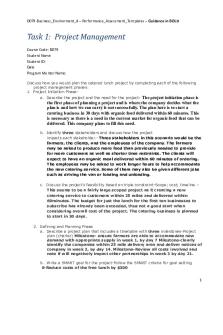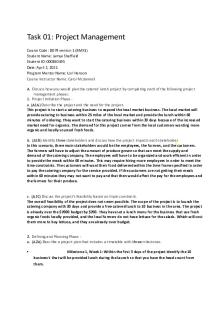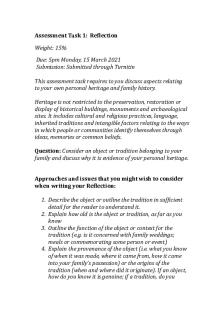Eugene Perkins YST1 - Task 1 PDF

| Title | Eugene Perkins YST1 - Task 1 |
|---|---|
| Author | Eugene Perkins |
| Course | Instructional Planning and Presentation in Elementary and Special Education |
| Institution | Western Governors University |
| Pages | 5 |
| File Size | 140.4 KB |
| File Type | |
| Total Downloads | 52 |
| Total Views | 125 |
Summary
Task 1...
Description
GENERAL INFORMATION Lesson Title & Subject(s): Heredity: Inheritance and Variation of Traits Topic or Unit of Study: Science Grade/Level: 3-5 Instructional Setting: This is a self-contained general education classroom in an elementary school. My class is comprised of a variety of students with various abilities and backgrounds: • 26 students total (15 boys and 11 girls) • 19 students are on-grade-level readers • 5 students are two grades above reading level (2 with identified gifted exceptionalities) • 2 students are English language learners at the intermediate level . STANDARDS AND OBJECTIVES Your State Core Curriculum/Student Achievement Standard(s): Students who demonstrate understanding can analyze and interpret data to provide evidence that plants and animals have traits inherited from parents and that variation of these traits exists in a group of similar organisms. Lesson Objective(s): Given a graphic organizer and a picture book, the student will list the similarities and differences within a family of cats with 80% accuracy.
MATERIALS AND RESOURCES Instructional Materials: Students will need a worksheet, a picture book of the animals they will be analyzing, and an index card. I will use a video projector as well as an interactive white board.
Resources: 3-LS3-1 Heredity: Inheritance and Variation of Traits. (n.d.). Retrieved May 26, 2020, from https://www.nextgenscience.org/pe/3-ls3-1-heredity-inheritance-and-variation-traits
INSTRUCTIONAL PLAN Sequence of Instructional Procedures/Activities/Events (provide description and indicate approximate time for each): 1.
Student Prerequisite Skills/Connections to Previous Learning:
● ● ●
Students must know how to complete a graphic organizer Students must know how to use a picture book Students must be able to recognize patterns and similarities
2. Presentation Procedures for New Information and/or Modeling: Presentation Procedures for New Information:
The purpose of this lesson is to have students understand that animals have many different traits but also have similar traits. Also, students will understand that traits are passed from parent to offspring. I will begin the lesson by showing a short video clip that shows the differences and similarities in the traits of dogs (Technology Strategy: Video). This will help the students relate to their background knowledge of all the different types of dogs as well as introduce new vocabulary that will be necessary for the lesson. The video will also have the students asking themselves questions about traits and heredity which will serve as a guide throughout the lesson.
3. Guided Practice: Students will work in heterogeneous groups with an assigned group leader (Grouping Strategy: Heterogeneous Groups). To begin I will have an example of their graphic organizer on a white board, I will show pictures of two different families of dogs and ask the students to give me some similarities and differences. I will give examples of different traits such as size, coloring, hair length, to each group and then call on them with guided questions to fill out the chart as a class. During this questioning the Gifted Learners will be asked higher level questions. I will then give the students a Think, Pair, Share activity (Active Participation Strategy: Think Pair Share activity). I will ask the students to think about what they have just heard or learned. Write down three statements about it on an index card. Now exchange your responses with your group. What were the most frequently mentioned ideas or terms?
4. Independent Student Practice: After completing the graphic organizer on dogs as a class, each group will work independently to complete the graphic organizer given a picture book of families of cats. Having completed the activity we will as a class complete the graphic organizer on the white board having the group leader from each group come up to fill out the traits for the family of cats. 5. Culminating or Closing Procedure/Activity/Event: At the conclusion of class students will turn in their graphic organizer (Assessment strategy: Graphic Organizer) about the commonly shared as well as different traits between parents and offspring of cats. Students will be able to identify correct traits and describe how they would use this knowledge in the future.
Instructional Strategy (or Strategies): One instructional strategy that was used in this lesson was the use of heterogeneous groups for cooperative learning. This strategy was used in the lesson when the groups were analyzing pictures of cat families in order to fill out their graphic organizer on common as well as different traits of cats. Differentiated Instruction Accommodations: ELL: For the ELL learners I provided picture books of the animals. Gifted: The gifted learners will be asked higher level questions during the guided practice portion of the lesson
Use of Technology: In this lesson I will use a video as well as an interactive white board. The students will also use the white board during the guided practice portion of the lesson. Student Assessment/Rubrics: Given a graphic organizer and a picture book, the student will list the similarities and differences within a family of cats with 80% accuracy
Part B
Active Participation Strategy: The active participation strategy that I chose was to do a “Think, Pair, Share activity.” I
chose to have the students complete this activity at the conclusion of the Guided Practice portion of the lesson. I chose this type of activity because it helps students to think individually about a topic or answer to a question as well as teaches students to share ideas with classmates and builds oral communication skills. Research has shown that the Think-PairShare strategy is a versatile and simple technique for improving students' reading comprehension. It gives students time to think about an answer and activates prior knowledge (All About Adolescent Literacy, 2020).
Grouping Strategy: The grouping strategy I chose to use was to group the students in heterogeneous groups. I chose to put the students into heterogeneous groups at the beginning of the guided practice portion of the lesson. I chose this strategy because the work must involve every member of the group, each person has a valid job to perform with a known standard of completion. Each member is invested in completing the task or learning goal and each member is accountable individually and collectively. Research has shown that heterogeneous grouping based on student ability is more beneficial for student achievement and student satisfaction (Wang, 2013). Technology Strategy: The technology strategy I chose for this lesson was to show a video. I used the video in the presentation procedures for new information portion of the lesson. I chose to use the video in this lesson because videos increase student engagement which helps boost achievement. Videos also offer the flexibility to pause or skip throughout the video to have class discussions or review particular areas. Research has shown that showing videos in class increases student motivation, enhances the learning experience, and aids in development potential and profound understanding of the subject (Hanzic, 2019).
Assessment Strategy: The assessment strategy I chose for this lesson was to have the students turn in their completed graphic organizers as a formative assessment. Students use their graphic organizer throughout the lesson and turn it in during the closing procedure portion of the lesson. I chose this type of assessment because graphic organizers can be used to assess prior knowledge, record learning during class, and organize knowledge after learning. Research has shown that graphic organizers can be used as powerful tools for probing and analyzing student thinking and learning. They are also a good alternative to longer, written assessments (Struble, 2007).
References:
3-LS3-1 Heredity: Inheritance and Variation of Traits. (n.d.). Retrieved May 26, 2020, from https://www.nextgenscience.org/pe/3-ls3-1-heredity-inheritance-and-variation-traits All About Adolescent Literacy. (2020). Retrieved May 27, 2020, from http://www.adlit.org/strategies/23277/ Wang, Z. (2013, December 01). Effects of heterogeneous and homogeneous grouping on student learning. Retrieved May 27, 2020, from https://cdr.lib.unc.edu/concern/dissertations/9z903079v Hanzic, L. V. (2019, January 24). 3 Top Benefits of Using Video In Education. Retrieved May 27, 2020, from https://www.covideo.com/using-video-in-education-benefits Struble, J. (2007, January). Using Graphic Organizers as Formative Assessment. Retrieved May 27, 2020, from https://www.nsta.org/publications/news/story.aspx?id=53173...
Similar Free PDFs

Eugene Perkins YST1 - Task 1
- 5 Pages

PCE Task 1 - Task 1
- 2 Pages

Task 1 - SUS101 Task 1
- 2 Pages

Qht1 task 1 - Task 1
- 3 Pages

QBM1 Task 1 - Task 1
- 5 Pages

C365 - Task 1 - Task 1
- 4 Pages

Task 1 - C226 Task 1
- 11 Pages

C304 Task 1 - TASK 1
- 16 Pages

DIT1 TASK 1 - Task 1
- 4 Pages

D078 Task 1 - task 1
- 2 Pages

Task d079 copy - Task 1
- 3 Pages

HMc Daniel Task 1 - Task 1
- 9 Pages

C227 Task 1 - Passed Task
- 22 Pages
Popular Institutions
- Tinajero National High School - Annex
- Politeknik Caltex Riau
- Yokohama City University
- SGT University
- University of Al-Qadisiyah
- Divine Word College of Vigan
- Techniek College Rotterdam
- Universidade de Santiago
- Universiti Teknologi MARA Cawangan Johor Kampus Pasir Gudang
- Poltekkes Kemenkes Yogyakarta
- Baguio City National High School
- Colegio san marcos
- preparatoria uno
- Centro de Bachillerato Tecnológico Industrial y de Servicios No. 107
- Dalian Maritime University
- Quang Trung Secondary School
- Colegio Tecnológico en Informática
- Corporación Regional de Educación Superior
- Grupo CEDVA
- Dar Al Uloom University
- Centro de Estudios Preuniversitarios de la Universidad Nacional de Ingeniería
- 上智大学
- Aakash International School, Nuna Majara
- San Felipe Neri Catholic School
- Kang Chiao International School - New Taipei City
- Misamis Occidental National High School
- Institución Educativa Escuela Normal Juan Ladrilleros
- Kolehiyo ng Pantukan
- Batanes State College
- Instituto Continental
- Sekolah Menengah Kejuruan Kesehatan Kaltara (Tarakan)
- Colegio de La Inmaculada Concepcion - Cebu


